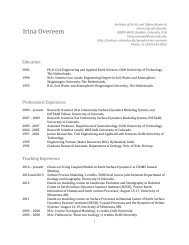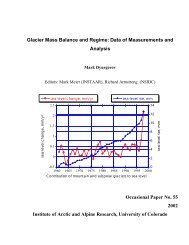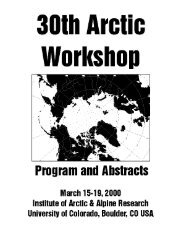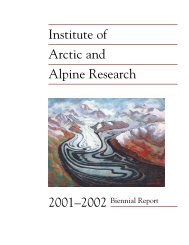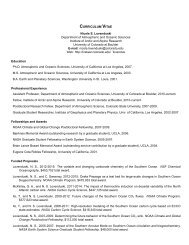The spread of modern humans in Europe - Proceedings of the ...
The spread of modern humans in Europe - Proceedings of the ...
The spread of modern humans in Europe - Proceedings of the ...
Create successful ePaper yourself
Turn your PDF publications into a flip-book with our unique Google optimized e-Paper software.
human dispersal along <strong>the</strong> Danube corridor, although it shouldbe noted that formerly associated human skeletal rema<strong>in</strong>s havebeen redated to younger time periods (7). Teeth associated withan early Aurigancian assemblage at Brassempouy (France) arenow assigned to <strong>modern</strong> <strong>humans</strong> (62).Evidence for assimilation or acculturation is reported from <strong>the</strong>Franco-Cantabrian region <strong>in</strong> <strong>the</strong> form <strong>of</strong> assemblages (Chatelperronian)compris<strong>in</strong>g Middle and Upper Paleolithic tool types,along with personal ornaments <strong>in</strong> at least one site (40). Unlike<strong>the</strong> Szeletian and Uluzzian sites described above, <strong>the</strong>se artifactsare associated with human skeletal rema<strong>in</strong>s that may be firmlyclassified as Neanderthal at two sites. <strong>The</strong>ir stratigraphic position<strong>in</strong> relation to <strong>the</strong> Aurignacian has been disputed, however.Some believe that <strong>the</strong>y are contemporaneous and <strong>in</strong>terstratifiedwith early Aurignacian assemblages (1), whereas o<strong>the</strong>rs suggestthat <strong>the</strong>y significantly antedate <strong>the</strong> latter and represent an<strong>in</strong>dependent development on <strong>the</strong> part <strong>of</strong> <strong>the</strong> local Neanderthalsbefore <strong>the</strong> appearance <strong>of</strong> <strong>modern</strong> <strong>humans</strong> (30). Yet ano<strong>the</strong>r view<strong>of</strong> <strong>the</strong> Chatelperronian is that <strong>the</strong> assemblages represent amixture (perhaps caused <strong>in</strong> part by cryoturbation dur<strong>in</strong>g HE4)<strong>of</strong> <strong>the</strong> latest Middle and earliest Upper Paleolithic occupations(12, 63).Summary and Conclusions<strong>The</strong> earliest evidence <strong>of</strong> anatomically <strong>modern</strong> <strong>humans</strong> <strong>in</strong> <strong>Europe</strong>is currently dated to 48,000 cal BP and <strong>the</strong> beg<strong>in</strong>n<strong>in</strong>g <strong>of</strong> <strong>the</strong> GI12 warm <strong>in</strong>terval. It is based on artifact assemblages (Bohunician)that are similar to an earlier <strong>in</strong>dustry <strong>in</strong> <strong>the</strong> Near East(Emiran) probably produced by <strong>modern</strong> <strong>humans</strong>. Bohuniciansites are present <strong>in</strong> South-Central <strong>Europe</strong> (27, 29, 32) andpossibly Eastern <strong>Europe</strong> as well, dur<strong>in</strong>g this <strong>in</strong>terval. Manypaleoanthropologists will want to see this conclusion supportedby discovery <strong>of</strong> <strong>modern</strong> human skeletal rema<strong>in</strong>s <strong>in</strong> <strong>the</strong>se sites orat least <strong>in</strong> a context that may be dated to <strong>the</strong> same period.Apossiblesecondmovement<strong>of</strong><strong>modern</strong><strong>humans</strong><strong>in</strong>to<strong>Europe</strong>may be represented by ano<strong>the</strong>r group <strong>of</strong> artifact assemblagesthat date to as early as 45,000–44,000 cal BP and GS11/GI 11. <strong>The</strong>y vary significantly <strong>in</strong> composition and aresometimes referred to as Proto-Aurignacian (27, 43, 50, 64).Many are similar to a contemporaneous <strong>in</strong>dustry <strong>in</strong> <strong>the</strong> NearEast (Ahmarian) manufactured by <strong>modern</strong> <strong>humans</strong> (1, 33).Proto-Aurignacian assemblages are found <strong>in</strong> Southwest andSouth-Central <strong>Europe</strong> and seem to be present <strong>in</strong> Eastern<strong>Europe</strong> at this time (50). Although <strong>the</strong> oldest known <strong>modern</strong>human skeletal rema<strong>in</strong>s <strong>in</strong> <strong>Europe</strong> date to this <strong>in</strong>terval, <strong>the</strong>yare not associated with artifacts (44). Never<strong>the</strong>less, <strong>the</strong> Proto-Aurignacian is widely attributed to H. sapiens on <strong>the</strong> basis <strong>of</strong>its apparent l<strong>in</strong>k to <strong>the</strong> Ahmarian and <strong>the</strong> artifacts, which<strong>in</strong>clude small backed bladelets and po<strong>in</strong>ts, personal ornaments,and bone/antler implements (30, 57).Both <strong>the</strong> Bohunician and Proto-Aurignacian sites probablyrepresent <strong>modern</strong> human population movements from <strong>the</strong> NearEast <strong>in</strong>to <strong>Europe</strong> via <strong>the</strong> Balkans. This conclusion is based on <strong>the</strong>proximity <strong>of</strong> South-Central <strong>Europe</strong> to <strong>the</strong> most probable source<strong>of</strong> <strong>the</strong> two sets <strong>of</strong> assemblages (i.e., <strong>the</strong> Levant). Central Asia isconsidered ano<strong>the</strong>r possible source <strong>of</strong> <strong>modern</strong> human populations<strong>in</strong> <strong>Europe</strong>, especially for adjo<strong>in</strong><strong>in</strong>g Eastern <strong>Europe</strong> (65).<strong>The</strong> Iberian Pen<strong>in</strong>sula and <strong>the</strong> Caucasus seem less likely routes,because local Neanderthal populations were present <strong>in</strong> bothareas until relatively late (66, 67). After <strong>the</strong> onset <strong>of</strong> cold HE4at 40,000 cal BP, a new <strong>in</strong>dustry (Aurignacian) possiblydeveloped <strong>in</strong> South-Central <strong>Europe</strong> <strong>spread</strong> rapidly throughout<strong>the</strong> cont<strong>in</strong>ent. Aurignacian assemblages are associated with <strong>the</strong>rema<strong>in</strong>s <strong>of</strong> <strong>modern</strong> <strong>humans</strong> <strong>in</strong> Western, Central, and Eastern<strong>Europe</strong> (1, 7, 10, 46, 52, 62).Although <strong>the</strong> Bohunician sites yield little direct or <strong>in</strong>directevidence <strong>of</strong> technological <strong>in</strong>novation, this may be caused <strong>in</strong> partby <strong>the</strong> functional and preservation biases <strong>of</strong> open-air lithicworkshops. If <strong>the</strong> caves conta<strong>in</strong><strong>in</strong>g bone po<strong>in</strong>ts traditionallyassigned to <strong>the</strong> Szeletian <strong>in</strong>dustry (11) are considered part <strong>of</strong> <strong>the</strong>same phenomenon [and added to an isolated bone implement <strong>in</strong>layer 11 at Bacho Kiro (36)], nonstone implements <strong>in</strong> <strong>the</strong>se sitesare comparable to those <strong>in</strong> <strong>the</strong> related Emiran or IUP <strong>in</strong>dustry<strong>of</strong> <strong>the</strong> Levant (37). Indirect evidence for organizational adaptations<strong>in</strong> <strong>the</strong> form <strong>of</strong> personal ornaments also is present <strong>in</strong>Bacho Kiro and <strong>in</strong> <strong>the</strong> related Emiran or IUP sites <strong>of</strong> <strong>the</strong> Levant(10, 36, 24). <strong>The</strong> pattern <strong>in</strong>dicates that although <strong>modern</strong> <strong>humans</strong>seem to have <strong>in</strong>itially entered <strong>Europe</strong> dur<strong>in</strong>g a warm climate<strong>in</strong>terval (GI 12), both technological and organizational <strong>in</strong>novations,reflect<strong>in</strong>g behavioral <strong>modern</strong>ity, may have facilitated <strong>the</strong>ircolonization <strong>of</strong> new environments.<strong>The</strong> extent to which <strong>modern</strong> <strong>humans</strong> and Neanderthals <strong>in</strong><strong>Europe</strong> exchanged genetic and/or cultural traits rema<strong>in</strong>s unclear.Significant niche overlap between <strong>the</strong> two species would seem topreclude susta<strong>in</strong>ed coexistence <strong>in</strong> <strong>the</strong> same region withoutsubstantial <strong>in</strong>terbreed<strong>in</strong>g. Evidence for <strong>in</strong>terstratifications <strong>of</strong>Neanderthal and <strong>modern</strong> human occupations is limited andproblematic, and <strong>in</strong> most places, <strong>modern</strong> human occupationdebris ei<strong>the</strong>r directly overlies traces <strong>of</strong> Neanderthal occupationor <strong>the</strong>re is a hiatus between <strong>the</strong> two (57, 61). Genic exchange is<strong>in</strong>ferred from <strong>the</strong> presence <strong>of</strong> anatomical traits <strong>in</strong> <strong>modern</strong> <strong>humans</strong>keletal rema<strong>in</strong>s that are common among Neanderthals andperhaps most parsimoniously expla<strong>in</strong>ed by <strong>in</strong>terbreed<strong>in</strong>g. <strong>The</strong>setraits could have evolved among <strong>modern</strong> <strong>humans</strong>, however, <strong>in</strong><strong>the</strong> absence <strong>of</strong> genic exchange with Neanderthals. Cultural<strong>in</strong>fluences are <strong>in</strong>ferred from <strong>the</strong> co-occurrence <strong>of</strong> artifactstypically made by both taxa, or <strong>in</strong> <strong>the</strong> case <strong>of</strong> <strong>the</strong> Chatelperronian,<strong>the</strong> reported co-occurrence <strong>of</strong> artifacts typically made byone taxon with <strong>the</strong> skeletal rema<strong>in</strong>s <strong>of</strong> <strong>the</strong> o<strong>the</strong>r. <strong>The</strong>re arealternative explanations <strong>of</strong> <strong>the</strong>se co-occurrences, however, and<strong>the</strong> evidence is not conclusive (63).ACKNOWLEDGMENTS. I thank R. G. Kle<strong>in</strong>, who <strong>in</strong>vited me to contribute thisarticle to <strong>the</strong> PNAS special feature and provided helpful comments on anearlier draft and V. T. Holliday and 2 anonymous reviewers for PNAS forcomments.1. Mellars P (2006) Archeology and <strong>the</strong> dispersal <strong>of</strong> <strong>modern</strong> <strong>humans</strong> <strong>in</strong> <strong>Europe</strong>: Deconstruct<strong>in</strong>g<strong>the</strong> ‘‘Aurignacian.’’ Evol Anthropol 15:167–182.2. Kle<strong>in</strong> RG (2008) Out <strong>of</strong> Africa and <strong>the</strong> evolution <strong>of</strong> human behavior. Evol Anthropol17:267–281.3. Tr<strong>in</strong>kaus E (2007) <strong>Europe</strong>an early <strong>modern</strong> <strong>humans</strong> and <strong>the</strong> fate <strong>of</strong> <strong>the</strong> Neandertals. ProcNatl Acad Sci USA 104:7367–7372.4. d’Errico F (2003) <strong>The</strong> <strong>in</strong>visible frontier. A multiple species model for <strong>the</strong> orig<strong>in</strong> <strong>of</strong>behaviorally <strong>modern</strong>ity. Evol Anthropol 12:188–202.5. Kivisild T (2007) <strong>in</strong> Reth<strong>in</strong>k<strong>in</strong>g <strong>the</strong> Human Revolution, eds Mellars P, Boyle K, Bar-YosefO, Str<strong>in</strong>ger C (McDonald Institute, Cambridge, UK), pp 21–32.6. Max Planck Institute for Evolutionary Anthropology (2009) Draft Version <strong>of</strong> <strong>the</strong>Neandertal Genome Completed (Max Planck Institute for Evolutionary Anthropology,Leipzig, Germany).7. Tr<strong>in</strong>kaus E (2005) Early <strong>modern</strong> <strong>humans</strong>. Annu Rev Anthropol 34:207–230.8. Grootes P, Stuiver M, White J, Johnsen S, Jouzel J (1993) Comparison <strong>of</strong> oxygen isotoperecords from <strong>the</strong> GISP2 and GRIP Greenland ice cores. Nature 366:552–554.9. Fedele F, Giaccio B, Hajdas I (2008) Time scales and cultural process at 40,000 BP <strong>in</strong>light <strong>of</strong> <strong>the</strong> Campanian Ignimbrite eruption, Western Eurasia. JHumEvol55:834–857.10. Churchill S, Smith F (2000) Makers <strong>of</strong> <strong>the</strong> early Aurignacian <strong>in</strong> <strong>Europe</strong>. Yrbk PhysAnthropol 43:61–115.11. Allsworth-Jones P (1990) <strong>in</strong> <strong>The</strong> Emergence <strong>of</strong> Modern Humans, ed Mellars P (Ed<strong>in</strong>burghUniv Press, Ed<strong>in</strong>burgh), pp 160–242.12. Bar-Yosef O (2007) <strong>in</strong> Reth<strong>in</strong>k<strong>in</strong>g <strong>the</strong> Human Revolution, eds Mellars P, Boyle K,Bar-Yosef O, Str<strong>in</strong>ger C (McDonald Institute, Cambridge, UK), pp 207–217.13. Meignen L (2000) Early Middle Palaeolithic blade technology <strong>in</strong> southwestern Asia.Acta Anthropol S<strong>in</strong>ica 19:158–168.14. Mellars P (1996) <strong>The</strong> Neanderthal Legacy (Pr<strong>in</strong>ceton Univ Press, Pr<strong>in</strong>ceton).15. Hester J (1972) Blackwater Locality No. 1: A Stratified Early Man Site <strong>in</strong> Eastern NewMexico (Fort Burgw<strong>in</strong> Research Center, Ranchos de Taos, NM).16. Haynes CV, Huckell BB, eds (2007) Murray Spr<strong>in</strong>gs: A Clovis Site with Multiple ActivityAreas <strong>in</strong> <strong>the</strong> San Pedro Valley, Arizona (University <strong>of</strong> Arizona Press, Tucson).16044 www.pnas.orgcgidoi10.1073pnas.0903446106 H<strong>of</strong>fecker




